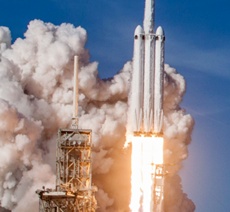SpaceX Falcon blasts off again; all eyes on Tintin
23 Feb 2018
Just two weeks after launching a Tesla Roadster car into space in the maiden flight of the Falcon Heavy rocket (See: SpaceX's Falcon Heavy rocket blasts off carrying Musk's red Tesla Roadster), Elon Musk's SpaceX was back in action on Thursday, launching a Falcon 9 carrying a $200 million Spanish radar imaging satellite and two experimental internet relay stations, which will act as pathfinders for SpaceX's proposed mega-network of orbital broadband beacons.
 The used Falcon 9 rocket blasted off from Space Launch Complex 4E at California's Vandenberg Air Force Base, carrying Spain's radar-imaging satellite PAZ and two SpaceX test satellites for global broadband.
The used Falcon 9 rocket blasted off from Space Launch Complex 4E at California's Vandenberg Air Force Base, carrying Spain's radar-imaging satellite PAZ and two SpaceX test satellites for global broadband.
Running a day late because of high upper level winds, the 229-foot-tall rocket blasted off at 9:17 am local time, streaking away to the south over the Pacific Ocean as it climbed toward an orbit around earth's poles.
The Falcon 9's first stage separated from the second stage a little over two minutes after lift-off. Cheers and applause broke out in the SpaceX control room as the launch was streamed live online.
The rocket's first stage - the ninth previously flown SpaceX booster to make a second flight - powered the vehicle out of the thick lower atmosphere and then fell away. No attempt was made to recover the used rocket, which crashed into the Pacific Ocean.
The company did, however, attempt to recover at least one of the nose cone panels that protected the satellite payload during the early moments of the flight. SpaceX has designed wing-like parafoils to guide the panels down to capture in a large net on a custom-designed ship - Mr Steven - stationed down range from the launch site.
SpaceX founder Elon Musk confirmed parafoil deploy, but the descending nose cone panel did not make it to the capture net.
"Missed by a few hundred meters, but fairing landed intact in water," Musk tweeted. "Should be able catch it with slightly bigger chutes to slow down descent."
'Mr Steven', a custom-built recovery ship, is equipped with a large net to capture Falcon 9 payload nose cone panels as they return to Earth under wing-like parafoils after they are discarded during launch.
The company hopes to perfect the technology to routinely recover the $6-million components for refurbishment and reuse.
Primary mission
The launch's primary mission is to deliver PAZ into orbit for the Spain-based company Hisdesat. The satellite has been deployed approximately 11 minutes after launch.
"Successful deployment of PAZ satellite to low-Earth orbit confirmed," the California-based company tweeted.
The single engine powering the second stage, meanwhile, fired for about six minutes and 20 seconds, putting putting Hisdesat's 1.5-ton PAZ (Peace) satellite into a 320-mile high orbit.
Using a sophisticated radar imaging system that can "see" earth's surface through clouds, day or night, PAZ is designed to capture images showing features as small as 9.8 inches across, covering an area of nearly 116,000 square miles every day. The imagery will be provided to the Spanish government and its allies as well as commercial users.
"It's a very flexible mission," Miguel Angel García Primo, chief operating officer of Hisdesat, told Spaceflight Now. "It's useful for a lot of applications, environmental, also for big infrastructure tracking and planning, maritime surveillance and government applications like monitoring and surveillance for any specific items that you'd like to follow."
PAZ will work in concert with two other synthetic aperture radar satellites already in orbit, TerraSAR-X and TanDEM-X, to provide very high resolution imagery and to shorten the time between overflights of high-priority targets.
Tintin A and B
While PAZ was the primary payload for Thursday's launch, much of the attention on the flight went to the secondary payloads, two SpaceX-developed orbital broadband prototypes known as Microsat-2a and Microsat-2b.
SpaceX did not mention the satellites in its press kit, but the company said in a 1 February letter to the Federal Communications Commission that the 880-pound relay stations would be aboard. And on Wednesday, SpaceX founder Elon Musk tweeted the Falcon 9 "carries 2 SpaceX test satellites for global broadband. If successful, Starlink constellation will serve least served."
In an FCC application last year, SpaceX proposed a vast network - Starlink - of up to 4,425 small satellites, orbiting at altitudes between 689 and 823 miles, broadcasting internet content in high-speed Ku- and Ka-band frequencies. The company also has proposed launching more than 7,500 satellites in lower 210-mile-high orbits using different frequencies.
"These (satellites) are meant to gather data in advance of deploying and operating a satellite constellation that will provide Internet service," Tom Praderio, a SpaceX firmware engineer, said during the company's launch webcast.
"However, even if these satellites work as planned, we still have considerable technical work ahead of us to design and deploy a low eEarth orbit satellite constellation," he said. "This system, if successful, would provide people in low to moderate population densities around the world with affordable high-speed internet access, including many that have never had internet access before."
The two microsats on board Thursday were released in the same orbit as PAZ. After checkout, both were to be manoeuvred into 700-mile-high orbits. The satellites are equipped with phased array antennas and optical links for communications between spacecraft.
Nicknamed Tintin A and B, both spacecraft were communicating with ground stations and appeared to be healthy. Musk said in a tweet the satellites "will attempt to beam 'hello world' in about 22 hours when they pass near LA. Don't tell anyone, but the wifi password is 'martians.'"
FCC Chairman Ajit Pai said last week he supported SpaceX's proposed Starlink network, saying "to bridge America's digital divide, we'll have to use innovative technologies". (See: Musk's SpaceX set to get nod for satellite-based broadband network).





















